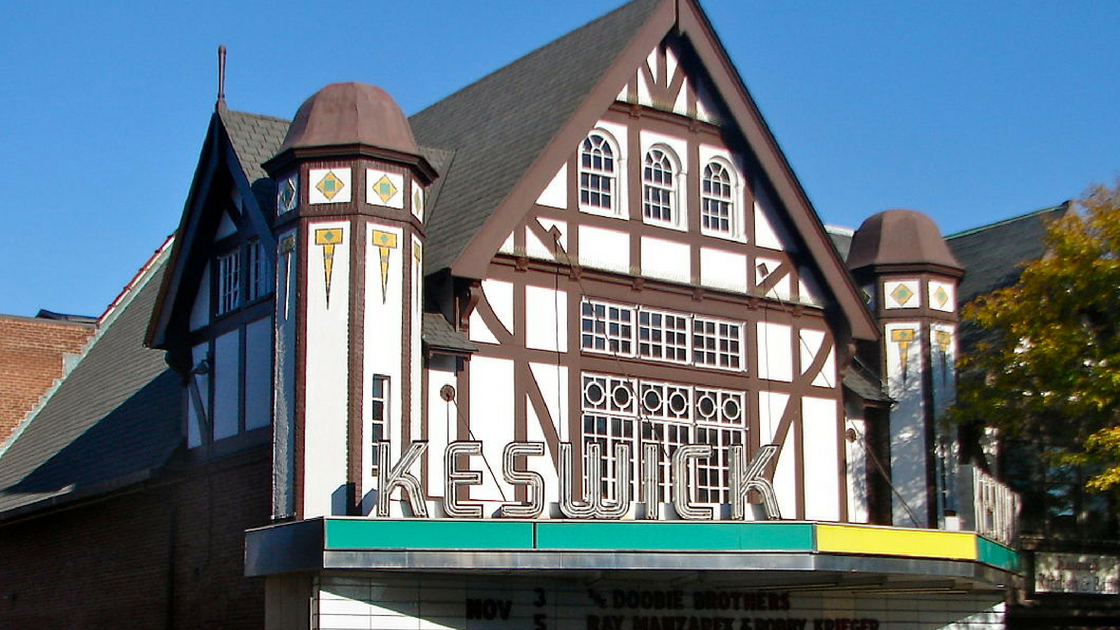The anchor of Keswick Village in Glenside is the Keswick Theater. The 1366 seat concert venue is considered one of the most “acoustically perfect” venues in the Philadelphia area. The theater presents a diverse mix of internationally acclaimed performers geared t virtually every entertainment taste and interest.
This historic theater first opened its doors on Christmas Night in 1928 with a private opening for the Kiwanis Follies. The Keswick opened to the public on December 27, 1928, with vaudeville and the movie “Glorious Betsy” but without sound, as the theater was wired for sound, but the equipment was not yet ready. The Keswick was nationally recognized as the most comfortable, acoustically perfect listening room in Philadelphia market.
The theater was designed in a Tudor Revival style by Philadelphia architect Horace Trumbauer, who also designed the Grey Towers Castle in Glenside (Arcadia), the Philadelphia Art Museum and Lynnewood Hall in Elkins Park.
When the Keswick opened in 1928, Vaudeville was in its final days and film was just being born, and the theater evolved into the area’s premier movie house. During the golden age of Hollywood, the excitement of going to the movies wasn’t only about seeing the stars on screen. It also meant spending time at the neighborhood movie theater, an architecturally ornate center of the community’s social life.
The Keswick Theatre’s organ was constructed by the M.P. Moller Organ Company of Hagerstown, Maryland in 1928. The instrument consists of nineteen ranks of contrasting tonality, a Marimba, Harp Celeste, Xylophone, Tubular Chimes, Glockenspiel. All are controlled by the special white console trimmed with gold, which is associated with the Style 150 Moller Theatre Organ. The organ has been restored and is operating.
In the spring of 1980, the Keswick sadly closed. Demolition loomed for the Keswick until the community came together and saved the theater. The activists founded the Glenside Landmarks Society, a non-profit with a mission of restoring the building to its former grandeur. The Keswick was placed on the National Register of Historic Places in 1983.
In 1981, the Keswick Theater reopened with a sold-out concert by Fred Waring and the Young Pennsylvanians. Over the next four years, stars like Roberta Peters, Carlos Montoya, Theodore Bikel, Buddy Rich, Lionel Hampton and the Preservation Hall Jazz Band graced the stage.
The Keswick Theater closed again in December 1985. The Keswick opened its doors again in March 1988, under private ownership. The Keswick Theater was fully refurbished in 1994. The new owners tackled the building issues and drastically increased the activity at the theater and successfully established the Keswick as a place to see great music. During that 15-year ownership, the Keswick blossomed in reputation and renovation.
The establishment of a restoration fund allowed for more than a million dollars in upgrades, including extensive updates in electrical and heating/ventilation systems, reupholstering seats, roof replacement and repair, extensive facade repair, and restoration of the original ornamental plaster. The Keswick grew technologically, as well, with state-of-the-art sound and light equipment and a computerized ticketing system. The growth was recognizes as the Keswick joined legendary venues like The Chicago Theatre, Beacon Theatre and Fox Theatre in “Pollstar’s Top 50 Theater Venues.” The Keswick became one of the Central Atlantic states’ most active and diversified venues, presenting internationally-acclaimed performers geared to virtually every taste and interest
Philadelphia Magazine chose the Keswick as ‘Concert Venue of the Year’ for its ‘Best of Philly’ issue. In 2004, an Arcadia paperback book on the Keswick Theater was published, written by Judith Katherine Herbst. The Keswick Theater was named Best local entertainment in Best of Glenside. Our readers are lucky enough to have such an incredible venue in the community.

